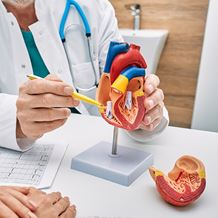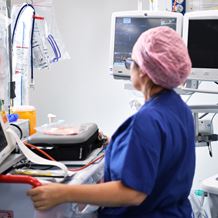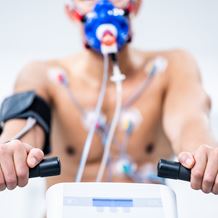
- Home
- Services
- Cardiac Services
- Procedures and Treatments
- Transoesophageal Echocardiogram (TOE)
What is transoesophageal echocardiogram?
A transoesophageal echocardiogram is a type of imaging technique that assesses how well your heart is working from inside your oesophagus. This type of procedure shows your doctor a more highly detailed picture of your heart structure than a standard echocardiogram would provide. During the procedure, a type of wand known as a transducer is inserted down the oesophagus. It then sends out sound waves that bounce back, or echo back, from the heart structures. The echoes are converted into images that provide a clear picture of the heart and how it is working.
What does it do?
A transoesophageal echocardiogram is able to identify problems with your heart valves and arteries. The images are taken from inside your oesophagus, a part of your body which sits right behind your heart. This means the pictures are clear and unobstructed. A TOE can check for:
- Infection (endocarditis)
- Heart valve problems
- Damage caused by a heart attack
- Problems with the aorta
- It can also be used to monitor your heart during an operation.
How does it work?
Optical coherence tomography works by inserting a special type of OCT catheter that emits a near infra-red light once it reaches the coronary arteries. An imaging probe collects the data produced from the light reflecting back, and converts this into high resolution images taken from inside the coronary arteries. These images are then displayed in real time which enables your doctor to assess the extent of any plaque build-up, evaluate the health of the artery walls, observe any abnormalities and make an informed treatment decision.
Why is it performed?
Your doctor may recommend a transoesophageal echocardiogram if they need more detailed information about your heart. It is used to evaluate symptoms of various heart conditions that typically include:
- Atherosclerosis – a build-up of plaque in the coronary arteries
- Cardiomyopathy – enlargement of the heart
- Heart failure
- Heart valve disease
- Heart infection
- Stroke
Procedure
A transoesophageal echocardiogram usually takes under one hour.
- A local anaesthetic is used to numb the back of your throat before the procedure begins
- The probe is guided through your mouth and down your throat
- Once in place, the images are taken and evaluated
- The probe is removed
Recovery
After the transoesophageal echocardiogram has finished you will be transferred to a recovery area and monitored until you are discharged by your treating doctor. Your throat may feel sore after the procedure, but you are likely to be able to resume daily activities as soon as the anaesthetic has worn off, and your gag reflex has returned. Learn more about transoesophageal echocardiogram recovery.
What's next?
If you have been experiencing heart-related symptoms, book an appointment with our cardiac services specialist today.
Our specialists in Cardiac Services
View all specialists





